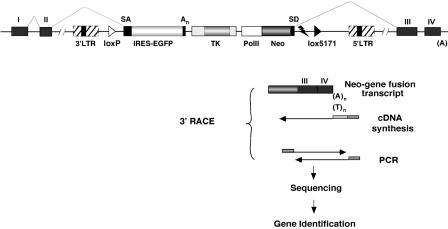Figure 1.
Tagged sequence mutagenesis with the LNPAT1 gene trap vector. An LNPAT1 provirus is shown integrated after the second exon (black) of a hypothetical gene. The Neo-resistance gene (dark gray shading), expressed from the RNA polymerase II (PolII) promoter, splices to downstream exons (III and IV). Transcripts of the disrupted gene, containing exons I and II, splice to coding sequences for the enhanced green fluorescent protein (EGFP) preceded by the ECMV internal ribosome entry site (IRES) in cells where the occupied gene is expressed. Cellular sequences appended to the 3′-end of virus-cell fusion transcripts are amplified by 3′-RACE and sequenced. The resulting sequence tags identify genes disrupted by the provirus and are subcloned for later use, for example, to prepare DNA microarrays. The resulting library of mutant ES cell clones, cryopreserved in liquid nitrogen, provides a source of mutant alleles that may be transmitted into the mouse germ line. A Herpes virus thymidine kinase gene (TK) and RNA destabilization element (flash symbol) are also present. Heterospecific loxP sites (loxP and loxP5171) allow vector sequences to be replaced by Cre-mediated cassette exchange (see text for details).

